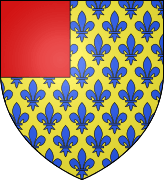Thouars
| Thouars | ||
|---|---|---|
|
The town hall in Thouars | ||
| ||
 Thouars | ||
|
Location within Nouvelle-Aquitaine region  Thouars | ||
| Coordinates: 46°58′33″N 0°12′51″W / 46.9758°N 0.2142°WCoordinates: 46°58′33″N 0°12′51″W / 46.9758°N 0.2142°W | ||
| Country | France | |
| Region | Nouvelle-Aquitaine | |
| Department | Deux-Sèvres | |
| Arrondissement | Bressuire | |
| Intercommunality | Thouarsais | |
| Government | ||
| • Mayor | Patrice Pineau | |
| Area1 | 12.09 km2 (4.67 sq mi) | |
| Population (2012)2 | 9,462 | |
| • Density | 780/km2 (2,000/sq mi) | |
| Time zone | CET (UTC+1) | |
| • Summer (DST) | CEST (UTC+2) | |
| INSEE/Postal code | 79329 / 79100 | |
|
1 French Land Register data, which excludes lakes, ponds, glaciers > 1 km² (0.386 sq mi or 247 acres) and river estuaries. 2 Population without double counting: residents of multiple communes (e.g., students and military personnel) only counted once. | ||

Thouars (pronounced: [twaʁ]) is a commune in the Deux-Sèvres department in western France.
It is on the River Thouet. Its inhabitants are known as Thouarsais.
History
Although there is evidence of human habitation here 5,000 years ago, it is only in the seventh century that the town appears in the historical record. In the 760s, Thouars found itself in Aquitaine, the most robust fortress in the entire region according to contemporary chroniclers. This was a violent decade as Duke Waïfre, struggling to preserve the independence of Aquitaine, fought against the expansionist ambitions of the French King, Pepin the Short. In 762, accompanied by his son, the future Charlemagne, appeared outside Thouars. He destroyed the Gallo-Roman town and torched the castle.
In the ninth century the first of a line of viscounts took charge of Thouars: he and his successors would control the fiefdom for more than five centuries until the end of the fourteenth century. The earliest of these Viscounts of Thouars for whom information survives is Geoffrey I, known as the founder of the Thouars dynasty. Located at the south of Anjou and at the frontier with Aquitaine, the Viscountcy of Thouars became a rich fiefdom with a strategic location extending from Upper Poitou all the way to the coast.
Aimery IV of Thouars was a Companion of William the Conqueror as a commander in the Battle of Hastings.[1]
In Angers in 1199, Guy of Thouars married Constance of Brittany to become Duke of Brittany jure uxoris, and after the death of Constance, Regent of Brittany for her daughter Alix of Thouars. Thouars was the birthplace of the medieval general Louis de La Trémoille. In 1619 his heir Henri de La Trémoille married Marie de la Tour d'Auvergne, sister of Turenne. She razed the old gothic château-fort to build the present château.
Main sights
- The castle of the Dukes of La Trémoille, designed by Jacques Lemercier and completed in 1635–1638. Its main façade is more than 110 m tall. After the Trémouilles were dispossessed during the French Revolution, the château became a barracks and later a prison. It has been restored for its present use as a middle school.
- Walls, with several historical towers (Tour du Prince-de-Galles, Tour Porte au Prévost)
- Church of Saint-Laone (12th century). It houses the tomb of Margaret Stewart, first spouse of King Louis XI of France.
- Church of St. Medard (15th century), in Romanesque style
- The Neo-Gothic Chapel of Joan of Arc
- Henri-Barré museum
People
Thouars was the birthplace of:
- Louis II de La Trémoille (1460–1525), general
- Charlotte Stanley, Countess of Derby (1599-1664)
- Jean-Hugues Anglade (born 1955), actor
- Prosper Depredomme (1918-1997), cyclist
Thouars is also the final resting place of:
- Margaret Stewart, Dauphine of France (1424-1445), daughter of James I of Scotland.
Twin towns
Thouars is twinned with:
-
 Diepholz, Germany
Diepholz, Germany -
 Port-Gentil, Gabon
Port-Gentil, Gabon -
.svg.png) Hannut, Belgium
Hannut, Belgium -
 Helensburgh, United Kingdom
Helensburgh, United Kingdom -
 Miedzyrzec Podlaski, Poland
Miedzyrzec Podlaski, Poland
See also
References
- ↑ "AimeryIVThouarsdied1093B". Retrieved 2015-03-25.
External links
| Wikivoyage has a travel guide for Thouars. |
| Wikimedia Commons has media related to Thouars. |

.svg.png)